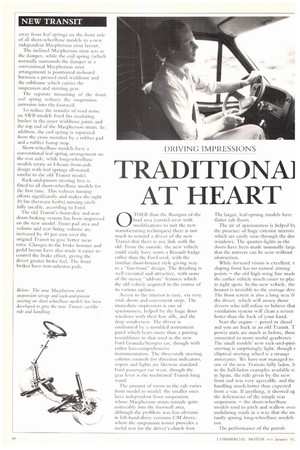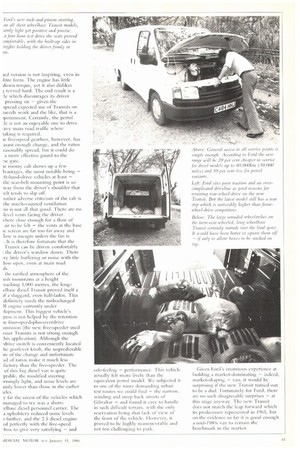TRADITIONA1 AT HEART
Page 44

Page 45

If you've noticed an error in this article please click here to report it so we can fix it.
0 1 11ER dun the the floorpan of the load area (carried over with modifications to suit the new manufacturing techniques) there is not much to remind a driver of the new Transit that there is any link with the old. From the outside, the new vehicle could easily have worn a Renault badge rather than the Ford oval, with the familiar short-bonnet style giving way to a "fast-frontdesign. The detailing is well executed and attractive, with none of the messy "add-onfeatures which the old vehicle acquired in the course of its various updates.
Access to the interior is easy, via very wide doors and convenient steps. The immediate impression is one of spaciousness, helped by the huge door windows with their low sills, and the deep windscreen. The driver is confronted by a moulded instrument panel which bears more than a passing resemblance to that used in the new Ford Granada/Scorpio car, though with rather less-comprehensive instrumentation. The three-stalk ste.Tring column controls for direction indicators, wipers and lights are likewise standard Ford passenger car wear, though the gear lever is the traditional Transit long wand.
The amount of room in the cab varies from model to model: the smaller ones have independent front suspension whose Macpherson struts intrude quite noticeably into the footwell area, although the problem was less obvious in left-hand-drive versions CM drove, where the suspension tower provides a useful rest for the driver's clutch foot.
The larger, leaf-sprung models have flatter cab floors.
The air of spaciousness is helped by the presence of huge exterior mirrors which are easily seen through the doe windows. The quarter-lights in the doors have been made unusually larp that the mirrors can be seen without obstruction.
While forward vision is excellent, t sloping front has no natural aiming points — the old high wing line made the earlier vehicle much easier to plac, in tight spots. In the new vehicle, the bonnet is invisible to the average driv The front screen is also a long way fr the driver, which will annoy those drivers who still refuse to believe that ventilation system will clean a screen better than the back of your hand.
Start the engine — petrol or diesel and you are back in an old Transit. T power units are much as before, thou connected to more useful gearboxes. The small models' new rack-and-pini( steering is surprisingly light, though t elliptical steering wheel is a strange annoyance. We have not managed to one of the new Transits fully laden, h in the half-laden examples available tc in Spain, the ride given by the new front end was very agreeable, and the handling much better than expected from a van. If anything, it showed ur the deficiencies of the simple rear suspension — the short-wheelbase models tend to pitch and wallow ovei undulating roads in a way that the mc tautly sprung long-wheelbase models not.
The performance of the petrol ied version is not inspiring, even in litre form. The engine has little down torque, yet it also dislikes 7 revved hard, The end result is :le which discourages its driver pressing on — given the
spread expected LISC of Transits on )areels work and the like, that is a pointment. Certainly, the petrol :le is not an enjoyable one to drive avy main road traffic where
taking is required.
ie five-speed gearbox, however, has asant enough change, and the ratios easonably spread, but it could do a more effective guard to the se gate.
Se roomy cab shows up a few ivantages, the most notable being — ift-hand-drive vehicles at least — the seat-belt mounting point is so way from the driver's shoulder that ielt tends to slip off.
aother adverse criticism of the cab is the much-vaunted ventilation im is not all that good. There are no level vents facing the driver
vhere close enough for a flow of air to he felt — the vents at the base ic screen are far too far away and low is meagre unless the fim is . it is therefore fortunate that the Transit can be driven comfortably the driver's window down. There Ty little buffeting or noise with the low open, even at main road ds.
the rarified atmosphere of the iish mountains at a height -oaching 1,000 metres, the longelbase diesel Transit proved itself a da sluggard, even half-laden. This definitely needs the turbocharged )1 engine currently under
lopinent. This biggest vehicle's „,,ress is not helped by the retention ie four-speed-plus-overdrive mission (the new five-speeder used esser Transits is not strong enough this application). Although the 'drive switch is conveniently located he geadever knob, the unpredictable ire of the change and unfortunate ad of ratios make it much less factory than the five-speeder. The of this big diesel van is quite 'ptable, the modified steering irisingly light, anti noise levels are ainiy lower than those in the earlier ides.
y Iir the incest of the vehicles which managed to try was a short
!elbase diesel personnel carrier. The .a upholstery reduced noise levels further, and the 2.5 diesel engine ell perfectly with the five-speed -box to give very satisfying — and
safe-feeling — performance. This vehicle actually felt more lively than the equivalent petrol model. We subjected it to one of the more demanding urban test routes we could find — the narrow, winding and steep back streets of Gibraltar — and found it easy to handle in such difficult terrain, with the only reservation being that lack of view of the front of die vehicle. llowever, it proved to be highly manouevrable and not too challenging to park.
Above: General access to all S(Tvirc points is simple enough. According to Ford the new range will be 20 per cent cheaper to service for diesel models up to 80,000km (50,000 miles) and 10 per cent less .14 p■Irol
Varian/S.
Left. Ford tilt's poor fri it Oil iiul an overcomplicated driveline as good reasons for retaining Year-whect-drive on the new Transit. But the latest model still has a rear step which is noticeably higher than frontwheel-drive competitors.
Below: The large rounded teheciarches On the twin-rear-wheeled, long u,heelhase Mansir certainly intrude info thc load spare. It would have been better to square them ',it 0111y 10 ill1011, /WATS 10 be Shit-keit' on top, Given Ford's enormous experience at building a market-dominating — indeed, market-shaping — van, it would be surprising if the new Transit turned MIE to be a dud. Fortunately for Ford, there are no such disagreeable surprises — at this stage anyway. The new Transit does not match the leap forward which its predecessor represented in 1965, but on the evidence so far it is good enough a NMI-1980s van to remain the benchmark in the market.






















































